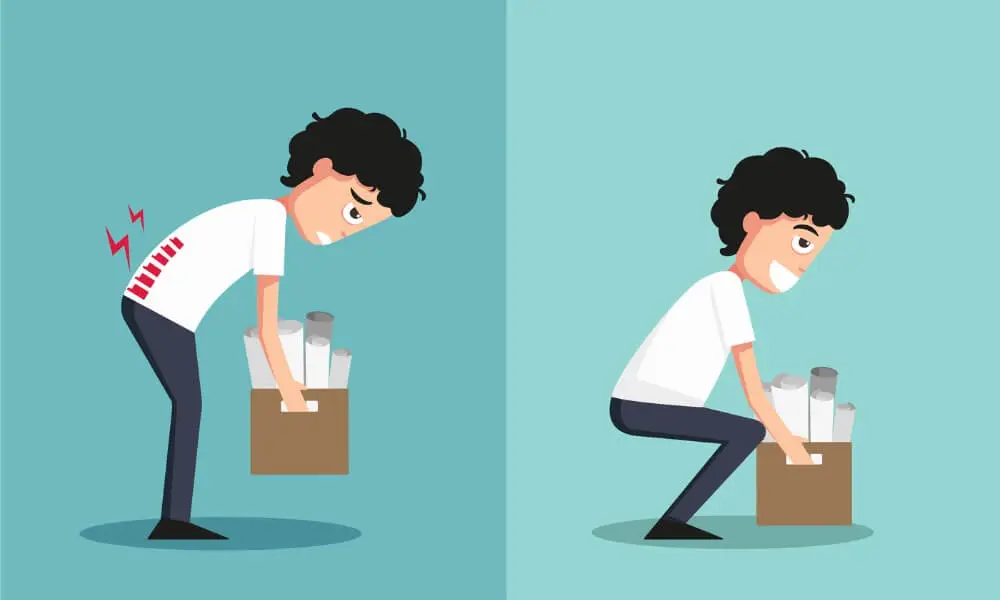In daily life, we often find ourselves in situations where lifting heavy objects is necessary. From moving furniture to unloading groceries, lifting objects safely is invaluable. However, improper lifting techniques commonly cause back pain and various injuries. Understanding and applying proper lifting techniques is beneficial and essential for long-term health and well-being.
In this blog post, we will give you the knowledge and strategies to lift heavy objects safely and efficiently. You will learn step-by-step methods, the importance of body mechanics, and how to minimize the risk of injury. This information is not only vital for those in physically demanding professions but is also tremendously beneficial for daily activities. Let’s empower ourselves to care for our bodies by mastering the art of lifting!
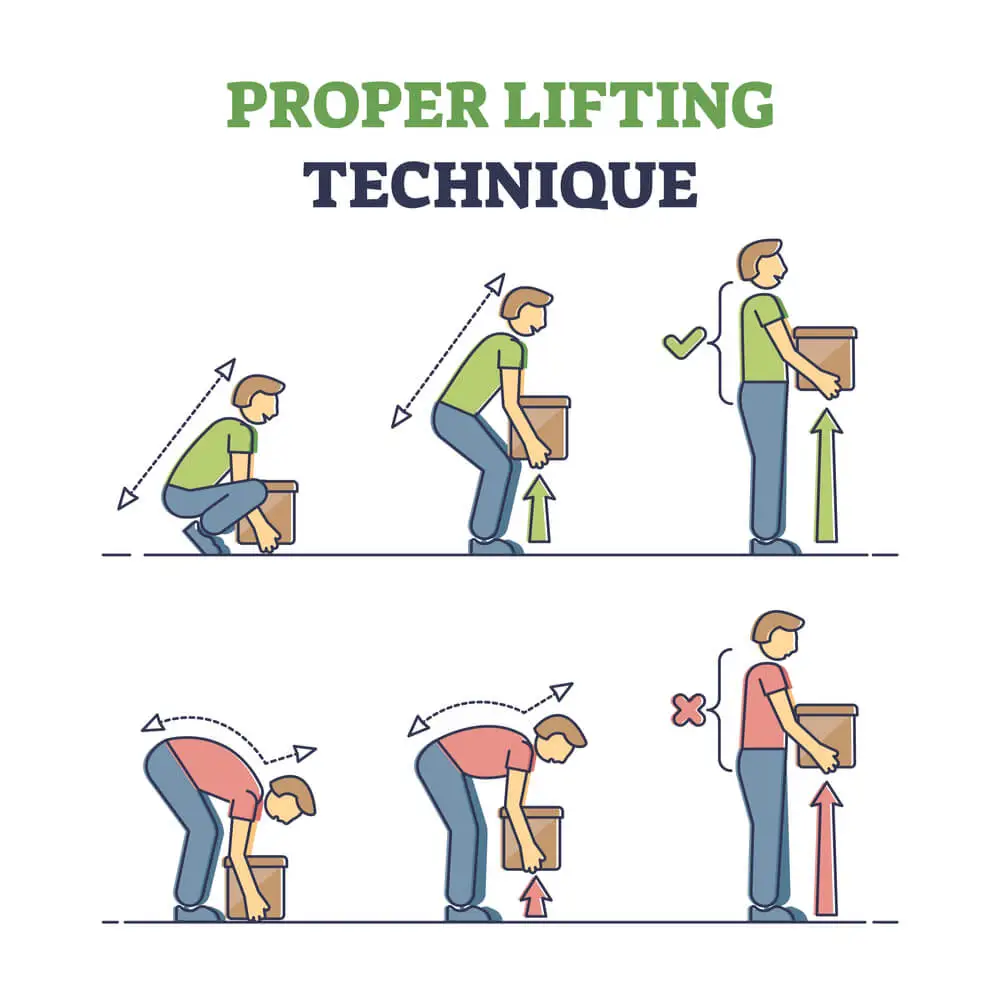
Safe Lifting Techniques Importance
The importance of safe lifting techniques cannot be overstated, as they play a critical role in preventing injuries and ensuring the well-being of individuals, especially in work environments where lifting is a common task. Here are some reasons why safe lifting techniques are essential:
- Prevention of Injuries: One of the primary reasons for practicing safe lifting techniques is to prevent injuries. Improper lifting can cause strains, sprains, and tears in muscles and ligaments. The back is particularly vulnerable, with many people suffering from lower back pain and injuries due to poor lifting practices.
- Long-term Health: Consistently using improper lifting techniques can have long-term effects on an individual’s health. For example, chronic back pain and musculoskeletal disorders can develop over time. Practicing safe lifting techniques helps maintain your long-term health and avoid complications later in life.
- Increased Productivity: When individuals practice safe lifting techniques, they are less likely to be injured, which means fewer workdays are lost to injuries. This leads to increased productivity in the workplace. Also, lifting objects safely and efficiently can make the task quicker and more manageable.
- Reduced Costs: Injuries from improper lifting can lead to medical expenses, workers’ compensation claims, and legal costs for employers. Individuals and companies can save on these unnecessary expenses by reducing injuries through safe lifting practices.
- Empowerment and Self-efficacy: Teaching individuals proper lifting techniques empowers them to take control of their own health and safety. This sense of self-efficacy can benefit all areas of life as individuals learn the value of mindful practices.
Safe lifting techniques are integral to personal and occupational health and safety. They are essential for the prevention of injuries, long-term well-being, productivity, and financial health for both individuals and organizations.
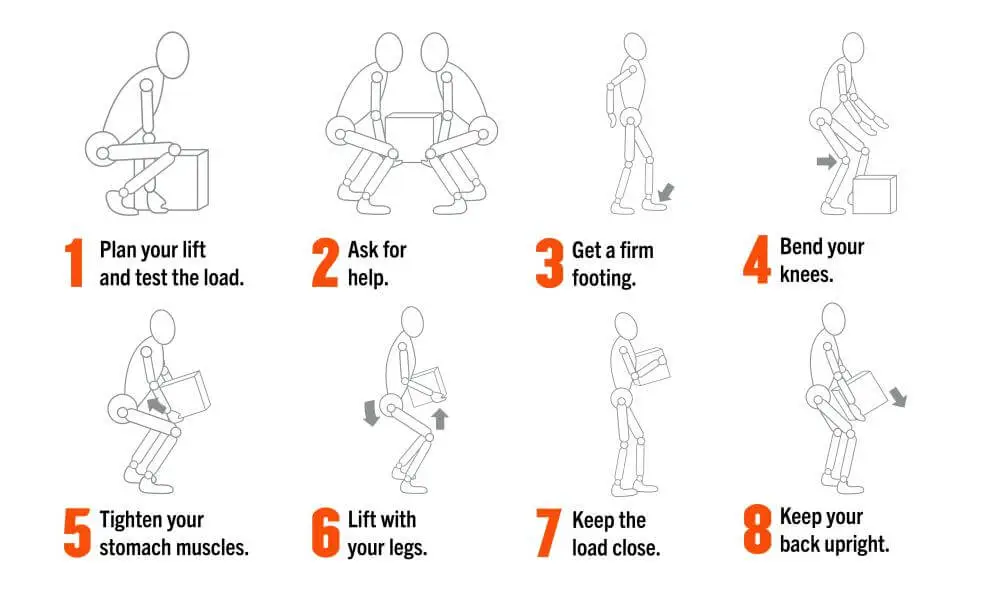
Proper Lifting Techniques | How To Lift Heavy Objects?
Proper lifting techniques prevent injuries and strains when lifting heavy objects. Here’s a step-by-step guide on how to lift heavy objects safely:
1. Remove obstructions from the route:
Before lifting a heavy object, you must ensure that your path is clear of any obstacles. This means taking a moment to survey the area and remove anything that might cause you to trip or lose balance while carrying the load. A clutter-free route is vital for your safety and to avoid dropping the object, which could damage it or cause injury. If the item is particularly heavy, it’s also a good idea to check if the floor or surface you’ll be walking on can support the weight without any issues.
2. Plan to rest the load midway on a table or bench for a long lift to change grip:
Plan ahead for resting points if you’re lifting something heavy and must carry it over a distance. This is especially important if the object is bulky or awkward to handle. You can briefly set the object down to readjust your grip or take a short break by positioning a table, bench, or any sturdy surface along your route. This is helpful in reducing fatigue and ensuring that you have a good hold on the object, minimizing the risk of dropping it.
3. Keep the load close to the waist and the heaviest side next to the body:
When lifting, it’s crucial to keep the object as close to your waist as possible. Holding it close minimizes the strain on your back and makes it easier to maintain balance. If the object has an uneven weight distribution, ensure that the heavier side is closest to your body. This positions the center of gravity near your own, which reduces the likelihood of straining your muscles and makes controlling the object much easier.
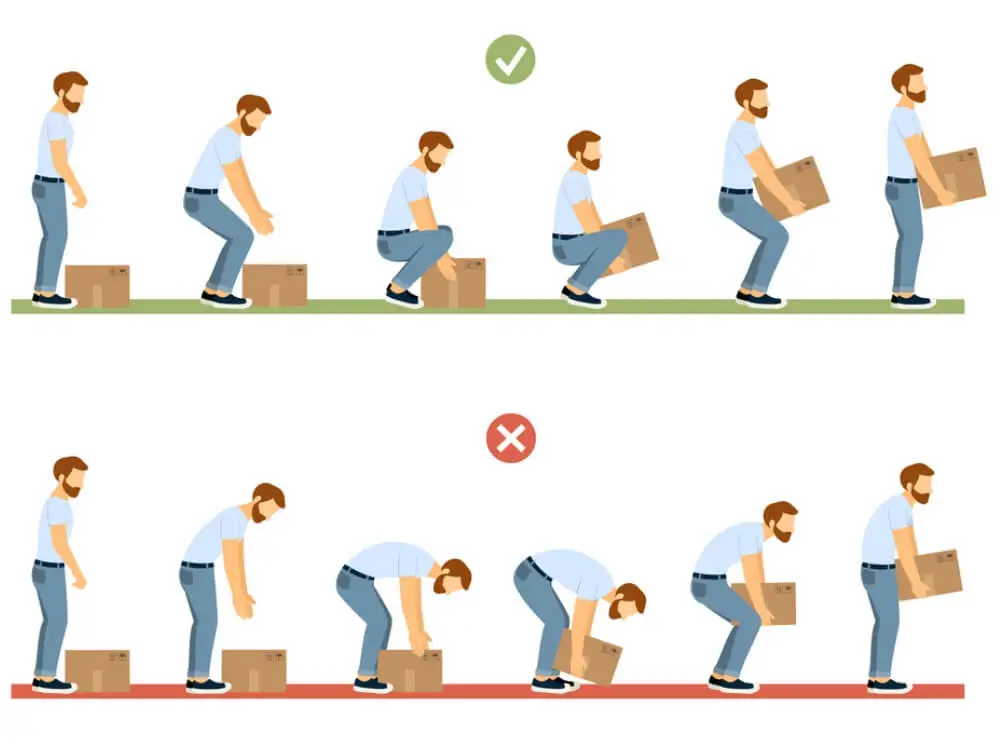
4. Adopt a stable position with feet apart and one leg slightly forward:
Before lifting, plant your feet shoulder-width apart, with one foot slightly ahead of the other. This stance forms a stable base that helps maintain balance throughout the lift. Your toes should be pointing in the direction you’re planning to move. If you’re wearing clothing restricting movement or shoes that don’t provide good grip, consider changing them before lifting. Adjusting your footing and moving comfortably is essential for safely handling heavy loads.
5. Get a good hold on the object:
When lifting an object, ensure you have a firm and comfortable grip. If possible, hug the item close to your body, as this can provide more support than using just your hands. For boxes or containers, try to get your hands underneath the object to utilize the strength of your arms and shoulders more efficiently. If the item is slippery or has an awkward shape, using gloves with a good grip or asking for assistance might be necessary.
6. Start in a good posture, and don’t flex the back any further while lifting:
Beginning with a good posture is essential for a safe lift. Keep your back straight and bend at the hips and knees. This position utilizes the strong leg and hip muscles during the lift rather than putting strain on the back. As you lift, make sure not to bend your back any further. The power should come from your legs pushing upwards while your back remains in its initial straight position.
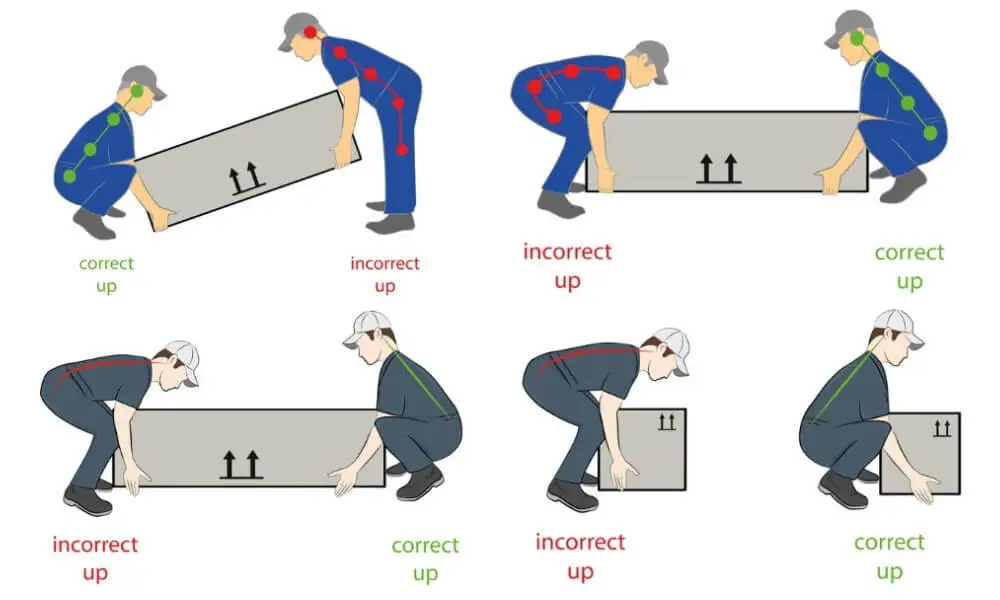
7. Avoid twisting the back or leaning sideways:
It’s important to keep your shoulders and hips aligned and facing the direction you want to move. Avoid twisting at the waist or leaning sideways, especially while your back is bent, as this can stress your spine unnecessarily. If you need to turn, move your feet and turn your whole body instead of just your upper half.
8. Keep your head up when handling the object:
Once securely lifted the object, keep your head up and look straight ahead. Looking down at the object can cause you to hunch your back, which increases the risk of injury. By looking ahead, you maintain a more natural posture and can better anticipate and navigate your surroundings.
9. Move smoothly and deliberately:
When carrying the object, it’s important to move in a controlled and smooth manner. Jerky movements or trying to rush can compromise your grip on the object and throw you off balance. Take your time, and if you feel like you’re losing control or becoming overly strained, it’s important to safely set the object down and reassess.
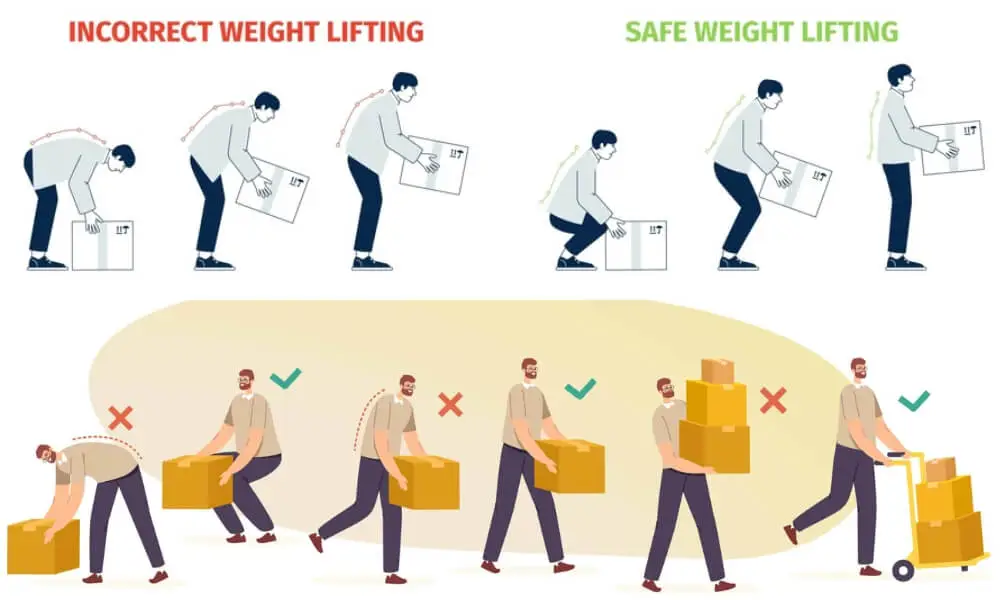
10. Don’t lift or handle more than can be easily managed:
Know your limits. There’s a significant difference between what you can lift and safely lift without injury. If the object seems too heavy or unwieldy, don’t hesitate to ask for help. Using lifting equipment or getting the assistance of a coworker can be the difference between a successful move and a serious injury.
10. Put down, then adjust:
When you reach your destination, put the object down gently by reversing the lifting process – bend at the hips and knees, keeping your back straight. If you need to make fine adjustments to its placement, it’s safer to set it down and then slide or reposition it. This ensures you’re not making those adjustments while under the strain of the object’s weight, which could lead to injury.
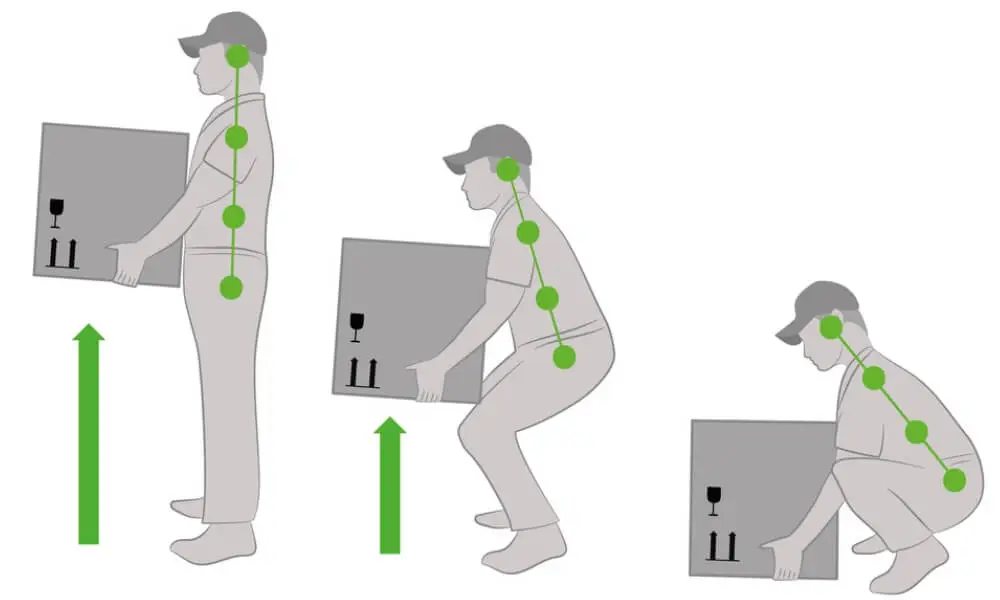
Common Lifting Problems
When it comes to lifting heavy objects, people encounter several common problems. These problems can lead to injuries or strains if not addressed properly. Here are some common lifting problems and techniques to help you overcome them:
- Lifting with your back: This is a common mistake where individuals rely primarily on their back muscles when lifting an object. This puts undue stress on the spine, leading to muscle strains and injuries. Lifting with your legs and hips is crucial, which are stronger and better equipped for handling heavy loads while keeping the back straight.
- Bending forward and keeping your legs straight to pick up an item: When you bend over to lift something without bending your knees, you are placing all the strain on your back and hamstring muscles. This can easily lead to pulled muscles or damaged ligaments. Instead, you should bend your knees and lower your body to the object, keeping your back straight.
- Twisting while lifting or carrying a heavy item: Twisting your upper body while lifting or carrying a load puts immense pressure on the spine and surrounding muscles. This can cause serious injury. Keeping your shoulders and hips aligned is vital, and moving your whole body in the direction you wish to go rather than twisting at the waist is vital.
- Lifting a heavy item above shoulder height: Reaching for and lifting an object above shoulder height can be dangerous as it compromises your center of gravity and strains your shoulders, neck, and upper back. Using a stool or ladder is recommended to get closer to the object and lift it close to your body.
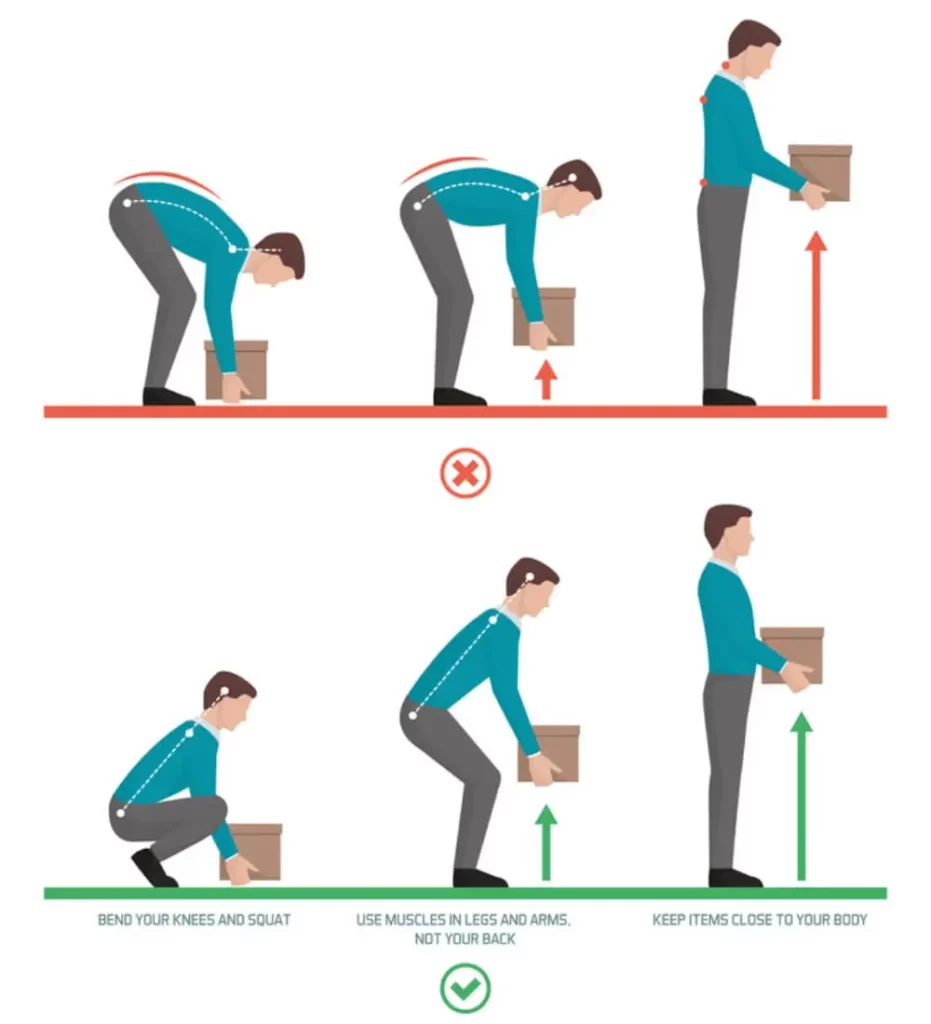
- Carrying an item that’s too heavy or large: Sometimes, individuals underestimate the weight or size of an object and attempt to carry it despite it being too heavy or cumbersome. This overexertion can cause muscle strains or falls. It’s crucial to assess the weight and size of the object and seek assistance or use lifting aids if needed.
- Using a partial grip (e.g., two fingers): Lifting heavy objects with an inadequate grip, such as using only a couple of fingers, places excessive strain on certain muscles and joints and increases the likelihood of dropping the object. Ensure a full, firm grip and if the object is too large or awkward, use lifting straps or ask for help.
- Lifting items when you’re tired, fatigued, or already injured: Your muscles do not perform at their best when your body is tired or injured. Lifting heavy objects in this state can easily result in further injuries. It’s important to recognize when your body needs rest or when an injury requires attention and avoid heavy lifting during these times.
- Holding your breath: Holding your breath while lifting can cause a dangerous increase in blood pressure and deprive muscles of oxygen needed during exertion. Breathing regularly throughout the lifting process is important, generally exhaling on the effort and inhaling as you release.
- Trying to lift and move the item too quickly: Rushing through lifting and carrying heavy objects is a recipe for accidents and injuries. It’s important to move deliberately and carefully, paying attention to your form and the environment around you to ensure safety.
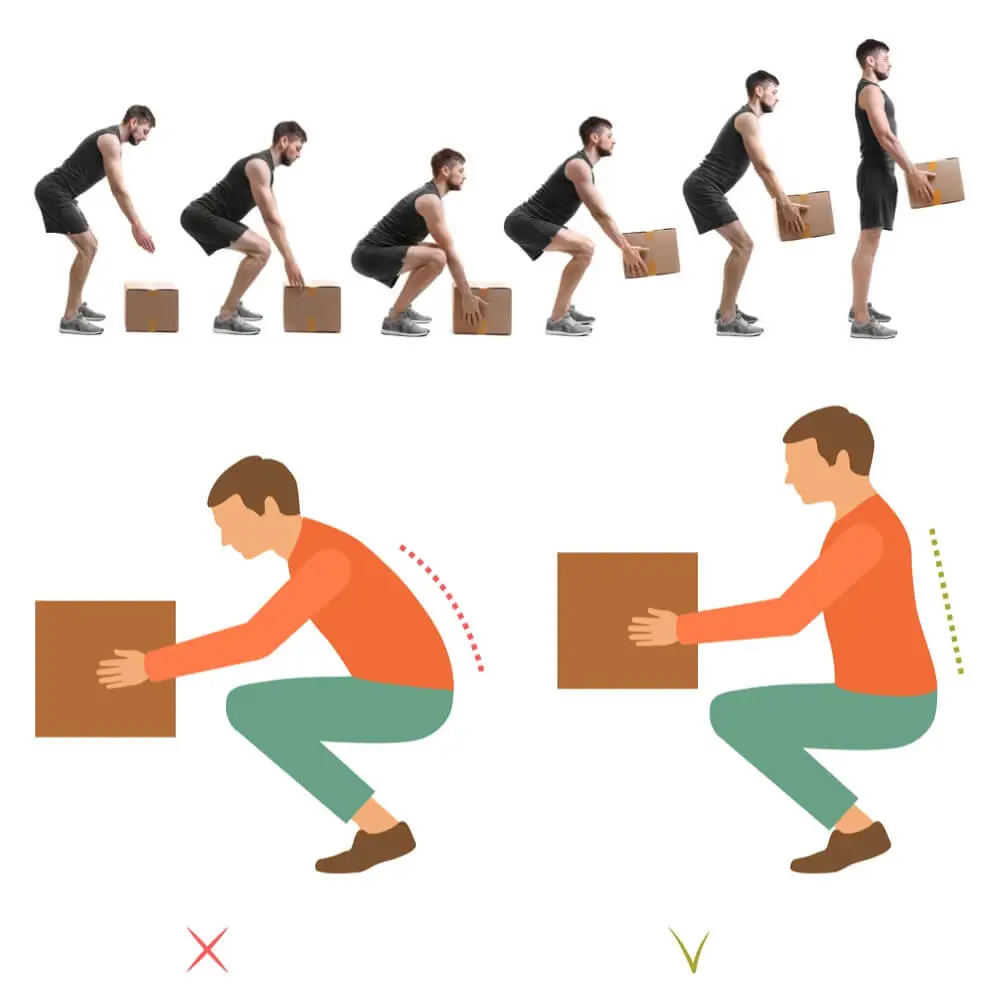
Conclusion
In conclusion, the way we handle and lift heavy objects plays a critical role in our physical health. This guide is an essential resource for anyone looking to minimize the risk of injury and ensure safe handling of materials. By adhering to the right lifting protocols, from assessing the load and preparing the lifting environment, to utilizing proper body mechanics and positioning, we can effectively protect our muscles, joints, and spine. Implementing these techniques is not just for the workplace but is a fundamental life skill that empowers us to perform daily tasks more safely and efficiently. Embrace these practices to foster a culture of safety and well-being for yourself and those around you.

